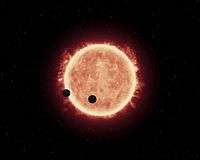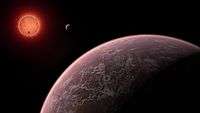TRAPPIST-1
 This chart shows the naked-eye stars visible on a clear, dark night in the constellation Aquarius (the Water Carrier). The position of the very red ultracool dwarf star TRAPPIST-1 is marked. Although it is relatively close to the Sun, it is very faint and not visible in small telescopes. Credit: ESO/IAU and Sky & Telescope | |
| Observation data Epoch Equinox | |
|---|---|
| Constellation | Aquarius |
| Right ascension | 23h 06m 29.283s[2] |
| Declination | –05° 02′ 28.59″[2] |
| Apparent magnitude (V) | 18.80 |
| Characteristics | |
| Spectral type | M8V[3] |
| V−R color index | 2.33 |
| R−I color index | 2.47 |
| Astrometry | |
| Radial velocity (Rv) | −56.3 km/s |
| Parallax (π) | 82.58 mas |
| Distance | 39.5 ± 1.3 ly (12.1 ± 0.4 pc) |
| Absolute magnitude (MV) | 18.4 ± 0.1 |
| Details | |
| Mass | 0.08 ± 0.009 M☉ |
| Mass | 83.8048 ± 9.428 MJup |
| Radius | 0.114 ± 0.006 R☉ |
| Luminosity (bolometric) | 0.000525±0.000036[4] L☉ |
| Luminosity (visual, LV) | 0.00000373[note 1] L☉ |
| Surface gravity (log g) | ~5.227[note 2][5] cgs |
| Temperature | 2550 ± 55 K |
| Metallicity | 0.04 ± 0.08 |
| Rotation | 1.40 ± 0.05 days |
| Rotational velocity (v sin i) | 6 ± 2 km/s |
| Age | > 0.5000 Gyr |
| Other designations | |
2MASS J23062928-0502285, 2MASSI J2306292-050227, 2MASSW J2306292-050227, 2MUDC 12171 | |
| Database references | |
| SIMBAD | data |
TRAPPIST-1, also known as 2MASS J23062928-0502285,[6] is an ultracool dwarf star[4][7] located 39.13 light-years (12.0 pc) away in the constellation Aquarius.
A team of astronomers headed by Michaël Gillon of the Institut d’Astrophysique et Géophysique at the University of Liège[8] in Belgium used the TRAPPIST (Transiting Planets and Planetesimals Small Telescope) telescope at the La Silla Observatory in the Atacama desert, Chile,[9] to observe TRAPPIST-1 and search for orbiting planets. By utilising transit photometry, they discovered three Earth-sized planets orbiting the dwarf star; the innermost two are tidally locked to their host star while the outermost appears to lie either within the system's habitable zone or just outside of it.[7][10] The team made their observations from September to December 2015 and published its findings in the May 2016 issue of the journal Nature.[9][11]
Nomenclature
The designation b, c and d derive from the order of discovery. The designation of b is given to the first planet orbiting a given star, and d to the furthest.[12] In the case of TRAPPIST-1, three were discovered, which were designated b, c and d, in order of increasing orbital periods.[4] The name TRAPPIST-1 derives directly from the fact that the star is the catalogued 1st star discovered by the TRAPPIST telescope to have transiting planets.
Stellar characteristics
TRAPPIST-1 is an ultracool dwarf star that is approximately 8% the mass of and 11% the radius of the Sun. It has a temperature of 2550 K and is at least 500 million years old. In comparison, the Sun is about 4.6 billion years old[13] and has a temperature of 5778 K.[14]
Due to its mass, the star has the ability to live for up to 4–5 trillion years, meaning that TRAPPIST-1 may be one of the few remaining low-mass main sequence stars when the Universe is much older than it is now, and when the gas needed to make stars will have been used up.[15] The star is metal-rich, with a metallicity ([Fe/H]) of 0.04, or 109% the solar amount. This is particularly odd as such low-mass stars near the boundary between brown dwarfs and hydrogen-fusing stars should be expected to have considerly less metals than the Sun. Its luminosity (L☉) is 0.04% of that of the Sun.
Planetary system
| Companion (in order from star) |
Mass | Semimajor axis (AU) |
Orbital period (days) |
Eccentricity | Inclination | Radius |
|---|---|---|---|---|---|---|
| b | — | 0.01111 | 1.510848 ± 0.000019 | — | 89.41 ± 0.41° | 1.113 ± 0.044 R⊕ |
| c | — | 0.01522 | 2.421848 ± 0.000028 | — | 89.5 ± 0.31° | 1.049 ± 0.050 R⊕ |
| d | — | 0.08 ± 0.06 | 18+54 −14 |
— | 89.87 ± 0.1° | 1.163 ± 0.065 R⊕ |
The three small planets orbit the dwarf closely (at 1%, 1.5% and 3% of the distance that the Earth orbits from the Sun). A year on the closest planet passes in only 1.5 Earth days, the second is in 2.4 Earth days and the orbit of the third planet is less certain, with a year passing in 4.5 to 73 Earth days.[9] It is important to note that tidally locked planets likely have very large differences in temperature between their permanently lit daysides and their permanently dark nightsides, which could produce very strong winds circling the planets, while making the best places for life close to the mild twilight regions between the two sides.
Strong XUV irradiation of the planetary system
An XMM-Newton X-ray study shows that the Earth-sized planets in the habitable zone of the star are subject to sufficient X-ray and EUV irradiation to significantly alter their primary and perhaps secondary atmospheres.[16]
Spectrum of TRAPPIST-1 b and c
The combined transmission spectrum of TRAPPIST-1 b and c rules out a cloud-free hydrogen-dominated atmosphere for each planet, so they are unlikely to harbor an extended gas envelope. Other atmospheres, from a cloud-free water vapor atmosphere to a Venus-like atmosphere, remain consistent with the featureless spectrum.[17]
Gallery
-

Artist's view of planets transiting red dwarf star in TRAPPIST-1 system[1]
-

This picture shows the Sun and the ultracool dwarf star TRAPPIST-1 to scale. The faint star has only 11% of the diameter of the Sun and is much redder in colour.
-

This artist's impression shows an imagined view of the three planets orbiting an ultracool dwarf star.
-

This artist's impression shows an imagined view from the surface one of the three planets orbiting an ultracool dwarf star.
-
This artist’s impression video shows an imagined view from close to one of the three planets orbiting an ultracool dwarf star just 40 light-years from Earth that were discovered using the TRAPPIST telescope at ESO’s La Silla Observatory. In this view one of the inner planets is seen in transit across the disc of its tiny and dim parent star. (4K Ultra HD Video)
- ^ "Artist's view of planets transiting red dwarf star in TRAPPIST-1 system". www.spacetelescope.org. Retrieved 21 July 2016.
Notes
- ↑ Taking the absolute visual magnitude of TRAPPIST-1 and the absolute visual magnitude of the Sun , the visual luminosity can be calculated by
- ↑ The surface gravity is calculated directly from Newton's law of universal gravitation, which gives the formula where M is the mass of the object, r is its radius, and G is the gravitational constant.
References
- ↑ "TRAPPIST-1b". Open Exoplanet Catalogue. Retrieved 2016-05-02.
- 1 2 Cutri, R.M.; Skrutskie, M.F.; Van Dyk, S.; Beichman, C.A.; Carpenter, J.M.; Chester, T.; Cambresy, L.; Evans, T.; Fowler, J.; Gizis, J.; Howard, E.; Huchra, J.; Jarrett, T.; Kopan, E.L.; Kirkpatrick, J.D.; Light, R.M.; Marsh, K.A.; McCallon, H.; Schneider, S.; Stiening, R.; Sykes, M.; Weinberg, M.; Wheaton, W.A.; Wheelock, S.; Zacarias, N. (June 2003). "2MASS All Sky Catalog of point sources". VizieR Online Data Catalog. European Southern Observatory with data provided by the SAO/NASA Astrophysics Data System. 2246. Bibcode:2003yCat.2246....0C.
- ↑ Costa, E.; Mendez, R.A.; Jao, W.-C.; Henry, T.J.; Subasavage, J.P.; Ianna, P.A. (August 4, 2006). "The Solar Neighborhood. XVI. Parallaxes from CTIOPI: Final Results from the 1.5 m Telescope Program" (PDF). The Astronomical Journal. The American Astronomical Society. 132 (3). Bibcode:2006AJ....132.1234C. doi:10.1086/505706.
- 1 2 3 4 Temperate Earth-sized planets transiting a nearby ultracool dwarf star eso.org. (pdf)
- ↑ Viti, Serena; Jones,, Hugh R. A. (November 1999). "Gravity dependence at the bottom of the main sequence". Astronomy and Astrophysics. 351: 1028–1035. Bibcode:1999A&A...351.1028V. Retrieved 6 May 2016.
- ↑ "2MASS J23062928-0502285".
- 1 2 "Three Potentially Habitable Worlds Found Around Nearby Ultracool Dwarf Star - Currently the best place to search for life beyond the Solar System". eso.org. Retrieved 2016-05-02.
- ↑ "AGO - Department of Astrophysics, Geophysics and Oceanography".
- 1 2 3 "Could these newly-discovered planets orbiting an ultracool dwarf host life?". The Guardian. 2 May 2016.
- ↑ "Three New Planets Are the Best Bets for Life". Popular Mechanics. 2016-05-02. Retrieved 2016-05-02.
- ↑ Gillon, Michaël; Jehin, Emmanuël; et al. (2016). "Temperate Earth-sized planets transiting a nearby ultracool dwarf star". Nature. 533 (7602): 221–224. doi:10.1038/nature17448.
- ↑ Hessman, F. V.; Dhillon, V. S.; Winget, D. E.; Schreiber, M. R.; Horne, K.; Marsh, T. R.; Guenther, E.; Schwope, A.; Heber, U. (2010). "On the naming convention used for multiple star systems and extrasolar planets". arXiv:1012.0707
 [astro-ph.SR].
[astro-ph.SR]. - ↑ Fraser Cain (16 September 2008). "How Old is the Sun?". Universe Today. Retrieved 19 February 2011.
- ↑ Fraser Cain (15 September 2008). "Temperature of the Sun". Universe Today. Retrieved 19 February 2011.
- ↑ Adams, Fred C.; Laughlin, Gregory; Graves, Genevieve J. M. "Red Dwarfs and the End of the Main Sequence". Gravitational Collapse: From Massive Stars to Planets. Revista Mexicana de Astronomía y Astrofísica. pp. 46–49. Bibcode:2004RMxAC..22...46A.
- ↑ Wheatley, Peter J.; et al. (2016). "Strong XUV irradiation of the Earth-sized exoplanets orbiting the ultracool dwarf TRAPPIST-1". Preprint. arXiv:1605.01564
 .
. - ↑ de Wit, Julien; et al. (2016). "A combined transmission spectrum of the Earth-sized exoplanets TRAPPIST-1 b and c". Preprint. arXiv:1606.01103
 .
.
Further reading
- Thomas Levenson (May 2, 2016). "Astronomers Have Found Planets in the Habitable Zone of a Nearby Star". The Atlantic. Retrieved July 31, 2016.
External links
- TRAPPIST-1, Planetary system website.
- ESOcast 83: Ultracool dwarf star with planets (video)
Coordinates: ![]() 23h 06m 29.383s, −05° 02′ 28.59″
23h 06m 29.383s, −05° 02′ 28.59″


.jpg)
